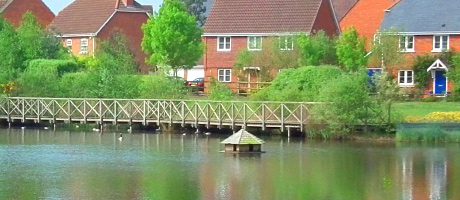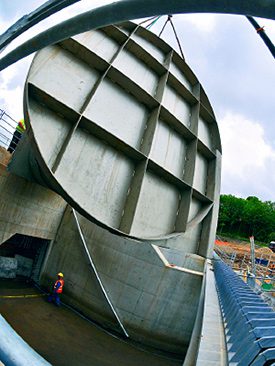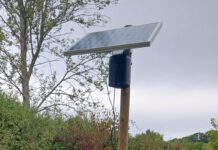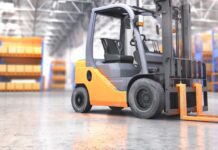Alex Stephenson enthuses over the contribution made by a naturally-occurring process to today’s technology.

SEEING beauty and elegance in natural patterns and processes is a fundamental human pleasure. We have an admiration for the simple and perfect way things work and an enthusiasm to capture and replicate them. The vortex is a particular object of fascination for those of us involved in design or engineering, because of its simplicity and power. Leonardo Da Vinci once said “simplicity is the ultimate sophistication” and simplicity can take a lot of hard work for designers to achieve. Despite its elegant principles, harnessing the power of the vortex effectively requires care, knowledge and expertise.
As it uses no power other than the energy of the water itself, vortex technology is inherently sustainable. It therefore feels like a very contemporary and unconventional solution, although in fact its use can be traced back through history. Now the latest step-changes in engineering development are moving the technology on once again, particularly in the design and application of the Hydro-Brake which, through its own success, has become an industry-standard term for flow controls. Because of this, specification of the correct technology is essential.

In the UK, vortex flow control technology was first harnessed in the mid 20th century to control and dissipate the energy of water dropping from high-level drains into deep-drop sewers. Following on from the drop-shaft innovations, the first Hydro-Brake flow controls were designed and developed in the 1970s and even featured on the Tomorrow’s World television programme in 1983, providing a glimpse of the future of sustainable drainage design.
Today, vortex technology is used in thousands of drainage and sewerage applications all over the world. It also provides the basis for hydrodynamic separation of silts, oils and pollutants from stormwater and of solids separation solutions in sewerage treatment.
Vortex flow controls are used in thousands of applications worldwide in all shapes and sizes, from giant flood prevention schemes to everyday small-catchment drainage schemes, from major flagship housing developments to more prosaic applications controlling the flows out of combined sewer overflows.
In the UK, new National Standards for Sustainable Drainage Systems (SuDS) will place increased expectations for controlling the flow and quantity of surface water in new developments. Vortex technology provides the perfect solution but its design and specification need careful consideration to meet the required standards effectively. It’s no secret that many vortex flow controls on the market are based on Hydro-Brake technology. The name Hydro-Brake has become a generic term rather like the Hoover to vacuum cleaners, or Biro to ballpoint pens. The specification of a ‘Hydro-Brake or equivalent’ is standard practice to designers using industry-standard modelling software packages.
Imitation may be a sincere form of flattery, but in the case of vortex technology substituting one product with another could lead to disaster. Whilst the technology may appear simple and elegant, the differences in engineering are significant. The choices made by designers and specifiers of flow controls have a huge impact on achieving effective flood prevention, as well as on the installation and lifetime costs of a project.
The internal geometry of a Hydro-Brake flow control is designed to enable water to flow unrestricted through it for as long as possible. When the water upstream reaches a pre-determined height, for example in a flood situation, a vortex is triggered in the flow. The vortex creates a core of air in the centre, throttling back the water and releasing it at a measured, controlled rate.
Compared with conventional technologies such as an orifice plate, penstock or slide gate valve, the flow of water out of a vortex flow control has much less energy per unit of cross- sectional area. It is therefore, much less likely to cause scouring or physical damage to downstream structures, protecting sensitive wetlands, ponds, basins or watercourses, even preventing damage to sewer infrastructure.
Bringing water quality back under control not only combats flooding but facilitates effective stormwater treatment practices. The reduction of peak flows causes less of a short-term shock pollutant load to the receiving waters and allows increased dilution. Now developments in vortex flow control technology have enabled new standards in design versatility to be reached, which can help designers achieve significant construction cost savings for their clients.

Flow controls have three basic elements: the inlet, outlet and the volute (the actual housing of the device which can either be ‘snail shaped’ or ‘cone shaped’). Traditionally there was a fixed relationship between these three components, with some models allowing a small level of sophistication by allowing a minor adjustment in the inlet or outlet. Now, in the Hydro-Brake Optimum all three elements are independently configurable, allowing engineers complete freedom to design each unit for absolute fit and to balance flow rates and surface water storage requirements to suit each drainage project. The result is optimised hydraulic efficiency and a storage saving of up to 15% compared with earlier technology, or alternative devices.
Alex Stephenson is chairman of the British Water SuDS focus group and Director of the UK Stormwater Division at Hydro International.
Images: Eighteen Hydro-Brakes were installed as part of the exemplar SUDS develoment at Elvetham Heath in Hampshire. Vortex Flow controls come in all shapes and sizes.






